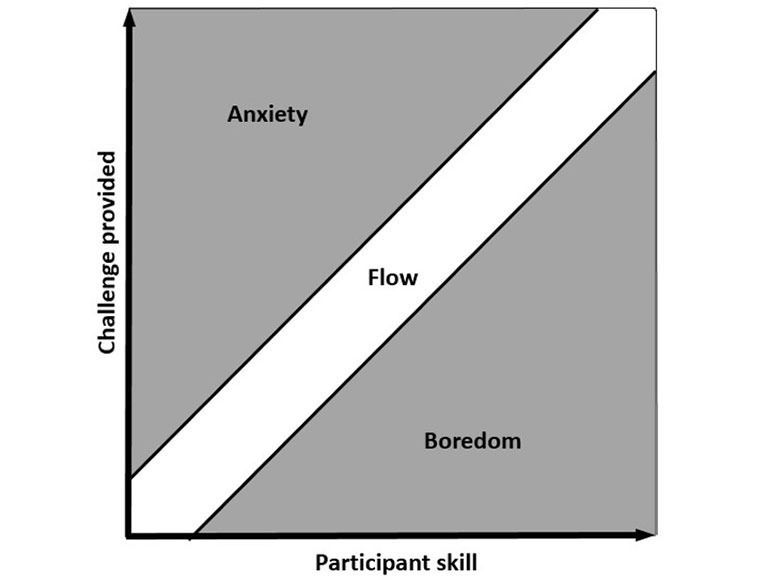Measuring flow
Real time measurement techniques like FaceReader might be the key to measuring flow in real-time.
Posted by
Published on
Tue 15 Mar. 2016
Topics
| Emotions | FaceReader | Facial Expression Analysis | Facial Expression Recognition Software | Psychology |

By Martijn van den Berg
Flow is a state in which a person is fully involved in an activity, decreasing self-consciousness and sense of time. This process requires a person to be extremely focused, as well as exactly have the skills to master a task.
Achieving flow is desirable, because during flow a person can reach maximum skill level as well as creativity within a domain [1]. However, measuring when a person is in flow and subsequently finding out how to get a person in a flow state is difficult, because flow causes persons to decrease self-consciousness, not recalling to what extent flow occurred [2].
Serious games
One of the main applications of flow is within serious gaming. Serious games are games which are used for other purposes than merely entertainment, mostly within education and behavior assessments. Games are a perfect tool for measurement of flow, because these naturally satisfy most of the ten building blocks required for flow [1]:
- There are clear goals every step of the way.
- There is immediate feedback to one’s actions.
- There is a balance between challenges and skills.
- Action and awareness are merged.
- Distractions are excluded from consciousness.
- There is no worry of failure.
- Self-consciousness disappears.
- The sense of time becomes distorted.
- The activity becomes an end in itself.
Methods of measuring fow
Several researchers have developed methods of measuring flow. Examples include interviews and surveys and the experience sampling method [2]. The experience sampling method requires participants to answer a questionnaire at several times during an activity. Doing so, however, interrupts focus and therefore also flow. More recently, several approaches were developed to measure experience, a factor related to flow [3].
This approach follows the building block of measuring whether skills and challenges are in balance, and is therefore more measurable.

While conducting a study on TeamUp, an offline virtual game in which four participants cooperate on separate laptops to complete various puzzles, speech and video was recorded to analyze emotions. When analyzing speech, we found that individuals achieving the best time at completing the puzzles were also least aroused by TeamUp (p: 0,422, s<0,001).
We also found that valence decreased as participants achieved lower times at completing the puzzles (p: 0,294, s: 0,017). When analyzing facial expressions, we found that mainly happiness and valence decreased as the challenges progressed (s<001).
The arousal findings in vocal analysis contradict initial hypothesis in [1] which states that arousal is only achieved at high skill and high challenge provided and [2], which states that flow is more likely achieved at high skill levels. These results can indicate either that the multiplayer nature of this game has an effect on arousal, or that high arousal is also reached at flow in a low skill level.
Valence and happiness findings confirm hypothesis by [1], indicating that happiness is not achieved when in flow, but is subsequently caused by flow. Subsequently, correlations between vocal temper and game time were expected, to indicate that participants achieving higher game times would become more frustrated. This could indicate that participants did not achieve frustration (mean: 29,55/100, SD: 5,25), or that vocal analysis is not a valid instrument in measuring flow.
Above findings are inductive and experimental. Although a lot of research exists on flow, few approaches exist in computerized measurement of flow. More research towards this subject is the first step in constructing systems which are able to adapt content to skill level.
Systems like these can be used to make more immersive games, provide more engaging education and increase employee productivity in a digital environment. Real time measurement techniques like FaceReader (video) and Beyond Verbal (speech) might be the key be able to measure flow real-time.
References
- Csikszentmihalyi, M. (1996). Flow and the psychology of discovery and invention. New York: Harper Collins.
- Nakamura, J.; Csikszentmihalyi, M. (2014). The concept of flow. Flow and the Foundations of Positive Psychology, 239-263. Springer Netherlands.
- Nacke, L. E.; Drachen, A.; Göbel, S. (2010). Methods for evaluating gameplay experience in a serious gaming context. International Journal of Computer Science in Sport, 9(2), 1-12.
Related Posts

Facial mimicry and social cognition in children with autism spectrum disorder

Assessment and training – positive behavior change

